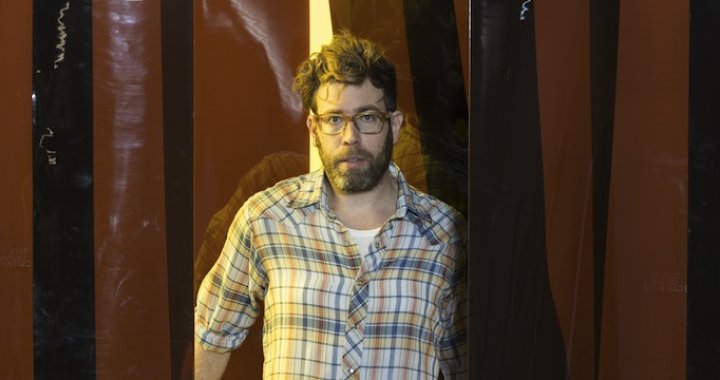
How to live with a really annoying roommate?
Elīna Zuzāne
09/01/2013
“My upbringing was very Swedish. It was very much in order. So I think art became a way out for me – it became an escape to another world that I subconsciously chose,” explains Christian Andersson. “Of course, being an artist has been difficult at times, but the choice was easy. I don’t know how to do anything else. It is scary, but it also helps. I have never had a “Plan B” in my life. I just realised that that is not how it works.”
Malmö-based artist Christian Andersson (1973) has been participating in various group exhibitions since 1998, but his most outstanding solo presentations to date include The Great and Secret Show by Christian Andersson (2012) at Von Bartha Garage gallery in Basel, and From Lucy with Love (2011) at Moderna Museet, Malmö, and Palays de Tokyo, Paris. At this moment, his moving Rorschach-test-sculptures are also part of the group exhibition, Inside and Out, at kim? contemporary art centre in Riga, where the exhibition is open for viewing through January 13, 2013.
When it comes to group exhibitions, you can never really influence who is going to be displayed next to you. How easy, or difficult, is it for an artist to participate in these shows?
It is a huge difference – making solo presentations and group shows. If I have made an object with a specific idea and, if that object is put next to someone else’s, those ideas are not solitary in the same way. My piece becomes a chapter, and it is not a full story. That’s just something that one has to accept. A couple of times I have declined my involvement in group exhibitions, but that’s when I feel that the curator wants to use my piece to explain something that was not on my mind when I was creating it. Then I feel that it’s not correct for me. At the same time, a piece can always mean many different things to a lot of different people and to a lot of different curators. The Rorschach tests could be part of fifteen different group shows, with many different concepts… as long as it’s politically going along with my ideas. The concept needs to be inspiring.
I take my work extremely seriously. That doesn’t mean that I don’t have a sense of humour, but I take my work very seriously, which is on the verge of being pretentious. I give a lot to the viewer, but I also ask a lot of them. If you went to see a solo presentation of mine, there would be a lot of mysteries to solve. It’s similar to when you go to the movies, or to a theatre play. You would expect that within two hours, you would have the full story of the film or play. You would not go there for just ten minutes and walk out saying, “I didn’t understand a thing. Who is this guy?” You need to see the full picture, which also means making a commitment. I feel the same way when doing an exhibition – if you will take time, there will be clues that will lead you somewhere. It doesn’t mean that I want to lead you into thinking exactly like I do, but it’s a starting point. It takes time.
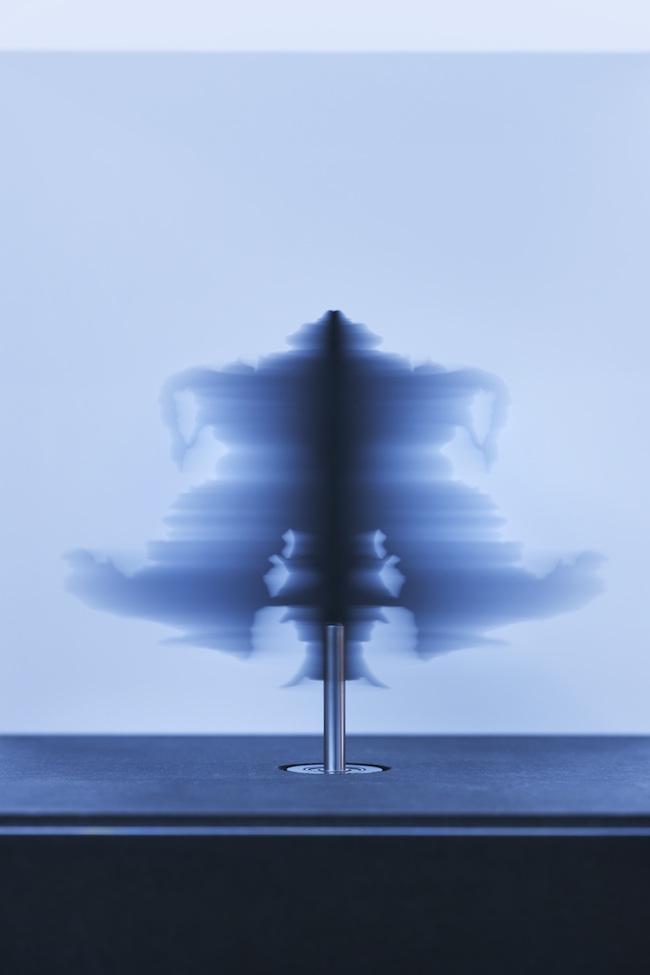
Rorschach installation. The Great and Secret show (plates I, IV, V, VI, VII). 2012. Wood, acrylic glass, engine, stainless steel. 180 x 30 x 30 cm. Photo: Andreas Zimmerman
How long do you think the viewer should spend time within your exhibition space?
Hours and hours! (Laughs) Last year, I did a large solo presentation at Moderna Museet in Malmö, Sweden. The exhibition space was about 6500 m2, and it contained seven big installations which were all, in a way, relying on each other. So, if you expected to grasp this whole idea – that had taken me a year and a half to develop – in 10 minutes, I would think it’s kind of rude. Or maybe you are super sharp. I don’t know.
It is a good question because it is a difficult one. Let’s say – I would ask the viewer to spend 45 minutes there. Minimum. (Laughs) Actually, there should be a tag which you would have to take by the door. And if people wanted walk out before the 45-minute mark, it would start to beep, as if you had stolen something. Then all the rest of the people would think, “Oh, that is a lazy viewer”. The person would feel ashamed and walked back in again. (Laughs) I will work on this.
How controlling are you within your creative process? Do you leave space for accidents?
I try to keep everything under control, but it doesn’t work. There are always things slipping through our fingers. I have become much more generous towards myself with errors, as they can actually be a good thing. If something happens, you shouldn’t be too hard on yourself. You just have to pull yourself together and say, “ ok, what happens now? Let’s try something else instead.”
I am a collector. I collect information and I’m desperately trying to put it together in a pattern. It’s an on-going work. Most likely, it’s going to take me until the day I die. In a way, it is a comfort – there is no way I can keep control over my entire work. What I’m presenting here at kim?, or in a bigger solo exhibition, is still just a slice of a bigger investigation. In that sense, it’s just like life – if someone steals your bicycle, it’s sad, but it’s not the end of the world. But I must admit that I am a bit of a control freak. Maybe subconsciously, I put myself into these positions to teach myself how to be a person that asks for less control in life. Some of the plans I have in art are difficult to follow. But you always have to push yourself to learn something. One of the exhibition pieces broke down yesterday and I thought to myself, why can’t I do small, little drawings, to which nothing could ever happen? But I don’t, because my whole urge is to be closer to the things that not even I have control over. It makes me feel that the mystery is still there. I always search for things that are not over and done. Otherwise, it becomes boring.
How do you keep this mystery alive?
When you are working with art, at one point you just have to leave it. Let’s say you are doing a big show that you have to develop within a year. It’s in your head and it’s with you all the time. So basically, it’s just like a really annoying roommate who is staying in your flat for a year. Then, suddenly, he moves out. Now it’s nice and quiet, but something is missing. All of the chaos is not there anymore. To finally let go of your idea is not easy. It helps if you know that someone else is taking good care of it.
It’s just as difficult to start making projects, because when they are in my head, they are perfect. But as soon as they go from the notebook out to my studio, it leaves the platonic state and becomes something else. That is just as painful. To be honest, the beginning – coming up with the ideas – that’s what it's all about. It’s a hope that the next idea is going to become a breakthrough for your brain, when you will experience “the click”. It’s fantastic. And having this for a job is the biggest luxury in the world. But it also comes with an obligation to present these ideas. That is an important part of the process. I need to make them into solid shapes just to have room for the next idea. It’s a circle. People have all kinds of working methodologies, but this is mine. I need to kick one roommate out and let another one in. And then begins another year of trauma. (Laughs)
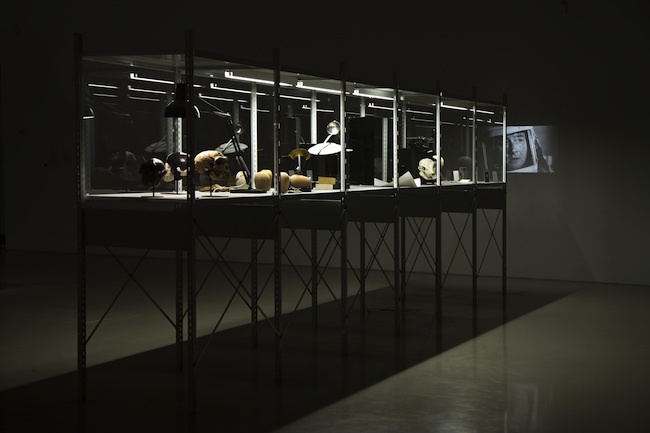
From Lucy with Love. 2011. Mixed media installation. 196 x 70 x 600 cm. Photo: Terje Östling/Moderna Museet
What takes longer – coming up with the perfect idea, or shaping it into a physical form?
It depends on the idea. Coming up with the idea definitely takes longer. It is years of something that is building up to a final idea. Taking Rorschach tests, for example – I found an old notebook from about three years ago, in which I had already written down a question – why are Rorschach tests two-dimensional? Subconsciously, that had been rolling around in my mind. It is a very organic and long process of accepting several thoughts at the same time. Today we mostly think about one thing at a time. We are focused on getting things to work. But I think that forcing a lot of thoughts into the same room is important, and that’s how my ideas, the crossbreed between them, start to grow. If you force fifteen roommates together in a single space, something will happen. It takes time and a lot of work. And then comes the part of refining these ideas into a physical shape. This, again, can take time, especially if you realise that no one would care about this particular piece of work. Then you have to think again. But sometimes, the solution takes you by surprise – you realise that it is very simple. Usually, however, if it’s simple, I get immediately suspicious.
To answer your question – coming up with the idea takes far much more time, but it also creates much more energy. Building an art piece, however, is just like any other thing – it’s very mundane and it’s done through hard work and experience. That is one good thing about getting older – you can cut through a lot of crap because you already know if many techniques would or wouldn’t work, just by considering the idea.
You said you are a collector of information. How does that work?
I have a madman’s system of post-it notes, cut-outs from magazines, postcards and movies… and everything is marked in a certain way. I go through these things all the time. Although the information is also in my head, I need the pool of these things to feel that it makes sense. If you only live with your mind, it’s a fairly tight spot to be in. You could start feeling that you are going insane, but when you actually see that there are other people thinking and talking about certain issues, you feel like you are a part of that. It creates a community. I think that is the key. Otherwise, you would go insane. I don’t want to do that. It is not the same as being creative. You can go mad, but crazy is a different thing. Alan Moore, who has written scripts for such graphic novels as Watchmen and From Hell, once said that the only difference between him and a crazy person is that he is not insane. I think it’s a fantastic idea, because it gives the word “crazy” an ability to expand your way of thinking. I don’t mind being called crazy, but I don’t want to be insane.
So is your studio like a mad scientist’s study?
It was until a couple of years ago. That was a very romantic idea that I had – to have my studio looking crazy. But after a while, I realised that that’s not the best way of dealing with my belongings. Now I try to keep it in order. It’s an archival system. The idea of an artist as this suffering romantic in the middle of chaos is too obstructive. That’s not for me. I like my studio to be in order. I am from Sweden. I like to organise things.
Is that true – do people in Sweden like to organise?
Yes. I think so. We already are in order as people.
What do you mean by that?
There has not been a big disorder in Sweden for hundreds of years. We don’t really know what disorder is. I think that it also creates a fear of disorder. For us, disorder is something abstract. Sweden is safe and sound, and healthy, but it also means that a lot of people are determined to keep it that way. We always stay in line. Here, in Riga, I was queuing for a burger and some kids cut into the line. The Swedish side of me was freaking out. I was thinking to myself – the line is here! But then I felt ashamed of myself. Cutting into line in Sweden is out of the question. We want to keep things in order.
Have you seen the film “Coffee and Cigarettes”, in which Lou Reed talks about Manhattan? He exclaims that New York doesn’t scare him, but he is scared of places like Sweden, where everything works and everyone is drunk. I have been thinking about that. What does it mean? Of course it’s a cliché. We don’t drink more than people do here or in Greece. But it’s the idea of “losing it”. The combination – everything works and everyone is drunk – is really freaky. Why would you want to be really drunk, if everything works? But that’s the thing – you would want to let go. I think that in really functioning places, like Switzerland or Sweden, you see people getting really drunk because it’s almost like an escape. You use alcohol as a drug to escape the grid, to feel that you are not “in order”.
It somehow seems that you prefer to look at what has been done in different fields in the past, instead of looking to the future. Am I correct?
I don’t think you can separate one thing from another. By looking at the past, you will be able to put together a pattern for the future. I am interested in history, but archaeology and history provides a very linear way of thinking. In Western history, for example, we think that everything started somewhere, and at some point, it will end. We are desperately trying to force all the events into this timeline, but it doesn’t really work. It is more complex than that and we are just now starting to realise it. What would happen if we found an artefact that was too old? Would we have to rewrite history? Can we be creative enough to say – lets have four or five parallel time lines? But by doing this, of course, we are thinking of the future in a very pragmatic way. We think that we are the crown jewel of everything, which is arrogant and not very productive if we want to plan the future. We should widen our sense of the future; not just think about the human future.
The future, as a concept, is actually dead. Up to the year 2000, people were thinking about the future as a concept, and at the year 2000, since it was such a round and nice figure, this concept just died. The idea of the future caught up with us and we didn’t really have a new kind of future other than what was already invented in the 1950s and 1960s. We are now in the future. People are still using bicycles and eating hotdogs; we don’t survive on nutrition cubes and fly in hovering space crafts. How do we deal with that? Did we not succeed in the future? I think that, at the moment, there is a beautiful confusion. We are living in the future of the past. How should we make a new future? It’s tricky to build the future when there is no utopia. My thoughts are a bit depressing, aren’t they? (Laughs)
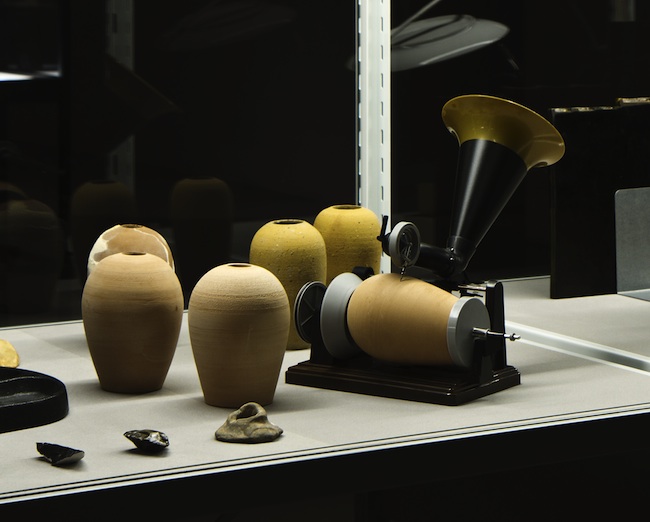
From Lucy with Love. 2011. Mixed media installation. Photo: Terje Östling/Moderna Museet
Within your sculptures and installations you often choose to highlight different historical events or moments in time, and then, by rearranging the facts and adding new elements, you manage to create an illusion of reality and the future.
I think it has to do with something that we already talked about a while ago – to create a situation in which you are allowed to think more than one thought at the same time. I am interested in creating a double feeling, or a double memory, in the viewer’s body. I want the viewers to look at my art and their bodies – to react to it as if something was wrong, as if something could not be correct. We have our foundation of knowledge, and when that is disrupted, we don’t really know what to do. We want to put it right. And that’s why my pieces are easy to decipher – you can sense that something has been disrupted. It is the viewer himself or herself putting it all together, by using logic. I was interested if the viewer could keep these two observations in his or her head at the same time. Will the first impact be of something being wrong? Or is it going to be the logical side that takes over? This has always been my interest.
When it comes to history, I try to stress this more than ever. I might not put together the most known part of history, but it’s there. If it’s only in my head, then it’s debatable, but if a museum is showing it, then it really becomes a part of history. And if someone writes it down, then it’s history. What I am telling you now becomes more credible than what it was 15 minutes ago. It’s so easy to change history. And it’s also very easily accepted. We don’t really question anything that, for example, the BBC tells us. I’m not saying that the BBC is lying, but we are very quick to accept things. We assume that if an expert says so, it must be true. How much do we actually know about anything these days? It takes a lot of effort to understand how things work. We just have very vague ideas. I like science and I like history, but I also think that it’s important for us to keep expecting more. We are getting a bit lazy. I will, again, sound pretentious or stupid, or crazy, but I want to encourage people to dig deeper. What at first glance does not mean anything, might actually be something incredible. If you will scratch the surface, you will find a lot of connections. It’s not rocket science.
Do you want the audience to question you and to question art?
That is a very good question. To question art in general? Not really. But that’s because I’m not really interested in that. I have a sister that’s five years younger than me, and she keeps questioning art in a way that really annoys me by asking – “is this art?” I love her to death, but it drives me crazy. I don’t like these dialogues because I become an arrogant person. It’s complex. It goes with what we talked about – how much do we know about anything? Conversations about “is this art?” are completely fruitless for me. I would love people to see my art as a font in a book and think, “Ok, I trust that you have found a forward, and now I’m going to look at the story”. I don’t want people to start questioning whether an “a” or an “e” should really look the way I have presented them. I think that there are so many artists who are good at putting the system of art into question, but it is not my field of interest. I want to tell stories in my own way, and so far, art is the best framework for that.
I would like to write a book, too. For me, it wouldn’t really make a difference. It would probably transform into a different shape and size, but I think the idea would be the same. I don’t believe that one thing is so different from the other.
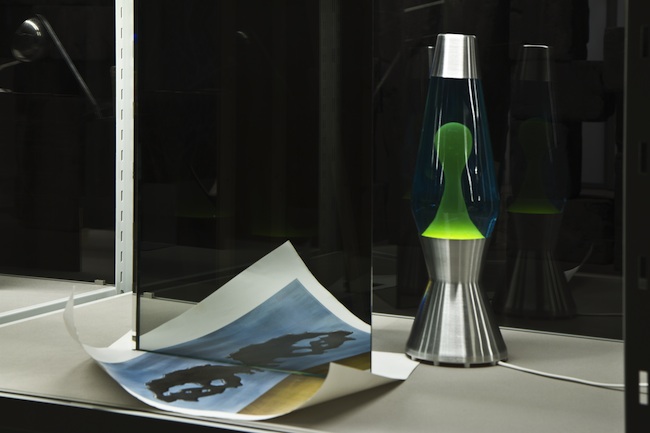
From Lucy with Love. 2011. Mixed media installation. Photo: Terje Östling/Moderna Museet
Would it be a detective story? Your exhibitions certainly resemble detective stories.
Exactly! They are a bit like detective stories. I couldn’t tell you what the book would be about. I don’t think I’m good enough to write pure fiction. That’s the beauty of art sometimes; it’s such a strange environment anyhow – the museum and “white cubes” and people dressing up and drinking wine. It’s almost like fiction. The ritual is so high above the ordinary. If you go to New York, and if you walk into the Gagosian gallery, it’s almost like a scene. It’s not real. Good-looking guys or girls, cast by their looks, are sitting there sipping small espressos. That is not reality. It is directed. I feel like, in the art world, you sometimes feel like in a theatre setting. It’s the kind of fiction that I like… on a small level. And if I can add more fiction to it, that’s something. But if I wrote about a Mr. Waker with a gun, solving crimes somewhere in Boston, most likely it would just be silly.
I’m now reading a brilliant book by Roberto Bolaño – “Nazi Literature in America”. It is so beautifully clever. I almost hate him for being so good. But then again, I love him for writing it. It is fiction, but it is not. It looks like non-fiction, but then it is fiction. That’s the best thing – when I don’t know what I’m reading.
So what is your current relationship with the gallery scene? Are you a part of it?
Oh, yes. I’m very much a part of that. Anything else would just be a lie. I make my money from galleries selling my art. That doesn’t necessarily mean that I have an active part in it. Part of the art world is about glamour, fashion and parties, but I am not as interested in that anymore. When you are young, parties are fun. I just turned 39, and it’s not so interesting anymore. There is no friction in that. Anyone can do that. It doesn’t demand anything from you. I am interested in other things. Don’t get me wrong – I love to hang out in bars with artists and friends, but as a lifestyle, it is not at all important to me.
Being rich is also not of importance to me, which means I’m not very interested in hanging out with the clientele who would buy my things. But if I can survive by doing what I do, and maintain my study, which is going to take me another 25 years to finish, that will be great. If I could do only this for the rest of my life, that will be fantastic. It’s a “give and take” situation. I think that sometimes, this fictional world is glorious. It’s fantastic that you have “white cubes” in a town. Why do people just accept that? We have these white spaces in which you can go inside of to look at art, and every few weeks, there is something else to look at. The idea is beautiful – to have these gaps in the city. But then you can also go to an art fair and just feel like shit for many different reasons. The art world is tough. There are many more artists that there are opportunities to show your art. That creates a tough environment. People would sell their mother for a show. I wouldn’t do that, but that’s the truth. It’s not just nice guys in the art world. But I am a part of this scene.
The Great and Secret Show by Christian Andersson at Von Bartha Garage gallery in Basel, 2012
The last two years have been an amazing time for you – a solo presentation at Moderna Museet in Malmö, and at Palays de Tokio in Paris.
You do your thing and participate in exhibitions thinking that nothing will probably come out of them, but three years later, someone calls you because they remember you from a certain show. That’s how I got invited in doing these shows. You should never forget that, once you have completed an artwork and it’s out there, you are instantly a part of the machinery.
Last year was also a big lift for me. I realised that I have a way of working now. When I did the show at Moderna Museet, it was a big change for me. I realised that I like to use the room as a piece of paper in order to tell the full story. All the pieces in there were of value to each other. You might think that that’s always the case, but it’s not necessarily so. I realised that I need to tell the story about where the show is perceived. I did an exhibition in a gallery in Basel, Switzerland, in which I used the works that were already in the gallery, and I created a fiction of myself as an artist making the show. The audience was left with the question – “Who is responsible for the exhibition and what is actually in the show”? I love that. I told you about that book that I loved. I wanted to create a similar experience for the viewer. That is the most beautiful thing that you can give someone. As you walked in, everything seemed to be clear, but then suddenly, you were confronted with an unexpected turn of events. What now? By the time you were walking back, everything seemed different. You had to see the show for a second time. It takes a lot of time to direct an exhibition like that. For me, that has been the breakthrough of thinking. I realised that this is what I want to do. This is how I want to tell my story. That is fantastic, because I can always take the energy from the place I want to exhibit in. The energy is always there and I can use it. That is new for me. It takes time to learn how to be an artist. It takes a lot of time.